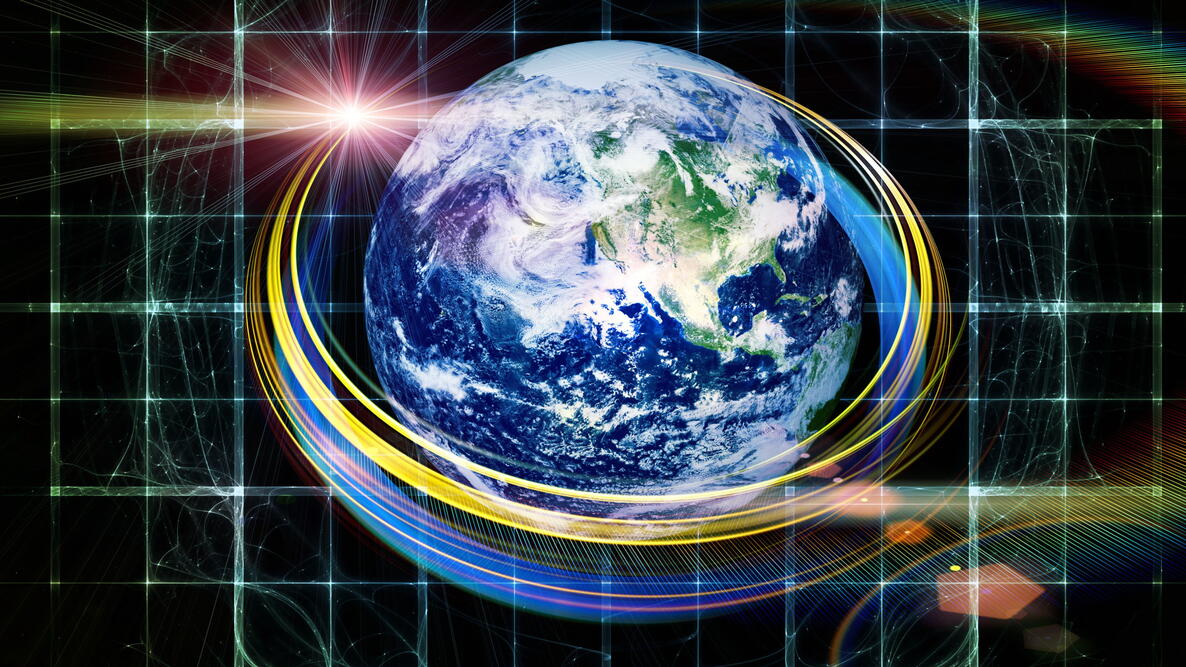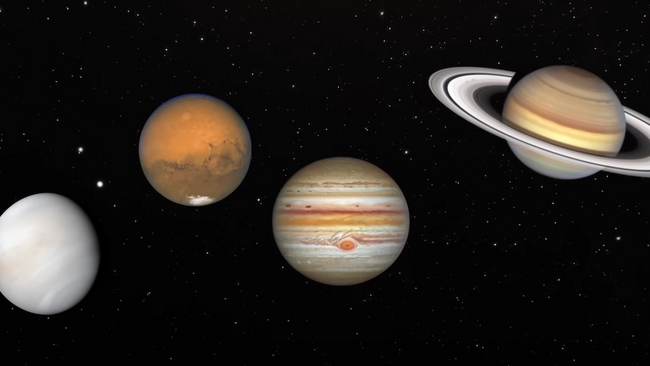Do you trust your instincts? Maybe you shouldn’t. It seems that ancient Greeks and the old church doctrines were correct because it sure feels as if we’re not moving. But we’re actually in wild, constant motion. How fast are we spinning—and why don’t we feel it?
On Earth, we don’t notice that the Earth is spinning. In contrast, when we gaze into the sky, we see constant animation of the Moon, Sun, and stars. They’re the ones that appear to be zooming. After rising upward, the Moon reliably moves to the right at a speed equal to an extended clenched fist every 40 minutes.
Of course, we’ve known for centuries that our homes partake in wild, constant motion. Since we don’t perceive it—and zooming at high speeds is a cool and fashionable thing to do—let’s briefly spell it out.
How Fast Are We Moving?
We’re on a ball whirling at 1,038 mph for those who live near the equator at places like Quito, Ecuador.
But at the North or South Pole, you stand still! So, Earth spins at a variable speed, and your velocity must logically lie somewhere between those two extremes. If you’re into math and have a calculator that can handle cosines, it’s easy to know exactly how fast your part of Earth is rotating. Enter your latitude—you do know your latitude, right?—and hit the cosine button. Then multiply that number by 1,038, and you’ll know how fast you move in miles per hour.
I’ll do the math. If you’re in New York, Indianapolis, or Denver at latitude 40 degrees, the spinning globe is whipping you around at 795 mph, faster than the speed of sound. So, if you ever lamely claim you didn’t hear your S.O. ask you to do something, maybe you can use that as an excuse.
But it’s really just the opening baby steps of your wild ride. Earth itself is also zooming at 66,600 mph in its solar orbit. This is more interesting than it might first seem. Because all planets have a simple, fascinating choreography as they eternally circle the Sun. To be stable and not be pulled into the Sun’s fiery oblivion by its enormous gravity, a planet near the Sun (we’re talking about you, Mercury) must have an enormous sideways speed.
So picture all planets moving in the same direction—counterclockwise if you’re observing from far above our North Pole—orbiting slower and slower the farther from the Sun they happen to be. This means that the planets nearest to us—Venus on the inside and Mars on the outside of our orbit—most nearly match our own speed of 19 miles a second.
Turns out, Venus goes 3 miles a second faster than we do, and Mars orbits 3 miles a second slower. This is actually good news. It means when we send rockets to those worlds and eventually launch people to Mars, we won’t need the extra fuel and energy to slow down or speed up very much. It’ll almost be like hopping off one carousel horse and mounting the one alongside us.
Where in space are we headed? Find out.
Why Don’t We Feel the Earth Moving?
As mentioned above, the Earth spins around its axis at up to 1,038 miles per hour, or about 0.30 miles per second, depending on location. [Meanwhile, Earth is also traveling at 66,600 miles per hour, or about 19 miles per second, along its orbit, and the entire solar system is traveling at about 144 miles per second in its orbit around the center of our Milky Way Galaxy (see “The Leap Second” below).] That is a VERY fast speed. So why don’t we feel this motion? The reason is that the speeds are constant. As people, we, the atmosphere, and Earth’s oceans are all spinning at the same speed.
Think of traveling in a car. You don’t feel much motion when you’re driving at a fast speed down a smooth highway. But when you hit the brakes, you feel the speed change. This is why we do not feel the Earth’s motions through the universe.
Does the Earth’s Speed Change?
Oh, yon inconstant Earth! We vary our speed! Earth moves fastest along its orbit in January when we’re nearest the Sun (that’s not a misprint), and we lope along most slowly in July.
That gives us more time to spin extra rotations during the summer months. It explains why the warm half of the year (March equinox through to the September equinox) is gifted by being a week longer than the cold half, a lovely fact known by absolutely no one you’ve ever met.
We also slowly change our rate of rotation, but this is one speed factoid that everyone knows about, even if everyone gets it wrong.
For more than a half-century, Earth’s clocks have been carefully kept in tune with our planet’s spin. Each day is defined as being 86,400 seconds long. Which naturally depends on seconds ticking reliably. Accurate timekeeping also depends on the Earth spinning at a constant rate. But, as everyone seems to know, our planet is slowing down, which sort of messes up the whole thing. But why do we slow?
Why is Earth Slowing Down?
The Moon pulls on the oceans, known since antiquity, because high and low tides happen 50 minutes later each day, just as the Moon rises and sets 50 minutes later each day. People naturally assume the 3-foot ocean bulge beneath the Moon happens because the Moon is lifting up the water.
But if you’d like to be the only person in your neighborhood to know the truth, the Moon cannot actually lift anything. You see, the Moon’s gravity starts out weaker than Earth’s, even at the lunar surface, and then gets wimpier and wimpier the farther you get from the Moon. When you consider its strength here at Earth’s surface, at the ocean, the Moon’s upward pull is only three millionths as strong as Earth’s gravity.
Three millionths. So, if you’re a drop of ocean water, which way will you go, downward or upward? There’s no chance anything on Earth will head toward the sky. This means the real puzzle is explaining that 3-foot sea-bulge under the Moon.
It’s simple. Picture a spot on the sea where you’d see the Moon rising or setting. Where it’s on the horizon or else lowish. That’s how it looks from most places. The Moon’s pull is then sideways. Horizontal. And no earthly gravity opposes it by yanking in the opposite direction. Therefore, most of the ocean has a lunar sideways or tractive pull that’s unopposed. So, the water slides sideways a bit. This small lunar tractive force adds up over the endless miles of ocean on both sides of Earth, slipping water sideways until it pools as a small bulge under the Moon.
Now you understand the tides. As our planet spins, the bulge reaches shallow coastal waters that make it rise a bit, explaining the average 5-foot tide at beaches.
This meeting of tides and beaches creates resistance. After all, countless billions of tons of seawater smashing into coastal rocks can’t be inconsequential, right? And this is what slows our planet’s spin.
The Leap Second
It’s not much of an effect. Our day gets one second longer after 750 centuries. A single second in 75,000 years. So why on Earth do we periodically add a “leap second” to keep our clocks in sync with our spin? We even added two extra seconds in 1972. It doesn’t make sense.
The reason is that when we initially set up the new timekeeping system to make clocks follow our planet’s spin, we needed to calibrate clocks to match Earth’s rotation, in which 86,400 seconds constitute one day. But we got it wrong! We used rotation data accumulated over more than a century, so when we “precisely” demarcated the second, we used a slightly incorrect interval. We officially define a second as the time it takes the nucleus of a cesium 152 atom to respond to 9,192,631,770 microwave vibrations, which then repeat 86,400 times while Earth spins exactly once. But that hasn’t been the true length of a day for 150 years.
In sum, we used the wrong period to define one second. To correct for that goof, we have to let the tiny error accumulate for a few years and then periodically add a leap second to the final minute of December or June.
You don’t need to know this. Especially if you only care whether your lawn and mailbox keep spinning slower. And the answer is: forget it. If you wish, you can add a second to your kitchen clock after 750 centuries.
On top of all that, our entire solar system is part of the Milky Way Galaxy, which, at our location, revolves around the giant black hole at the Galaxy’s center at 144 miles per second. Can you believe it? We’re moving 144 miles per second! This is the very fastest motion you are personally performing, although you can’t feel it since everything else is doing it, too.
Let’s quit there, because if we keep contemplating this, we’d next consider the expansion of the universe, which is carrying us at even faster speeds relative to other galaxies.
Bottom line: It may feel just like another lazy Sunday morning hanging out. But in truth, we are all going nowhere—fast!
Now, what’s the slowest-spinning planet?











Comments